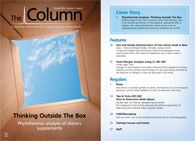Analyzing POPs in 50 μL of Blood Samples
Scientists from SGC Environmental Services in Wilmington, North Carolina, USA, have demonstrated the development and validation of a method for the analysis of five persistent organic pollutants (POPs) from 50 ?L dried blood spots. The work was presented as a poster at Dioxin 2014, held in Madrid, Spain, from 31 August to 5 September.
Scientists from SGC Environmental Services in Wilmington, North Carolina, USA, have demonstrated the development and validation of a method for the analysis of five persistent organic pollutants (POPs) from 50 μL dried blood spots. The work was presented as a poster at Dioxin 2014, held in Madrid, Spain, from 31 August to 5 September.1
Isotope dilution with single-ion monitoring gas chromatography coupled with high-resolution mass spectrometry (ID–SIM–GC HRMS) analysis was performed on 72 samples of human whole blood to detect PCBs 101, 105, 138; PBB-153; and lindane. The first validation study found issues with high background from blank paper samples, which was reduced by cleaning with a carbon dioxide regimen. The second validation study was more successful with recoveries ranging from 51% for lindane to 100% for PBB-153.
The Column asked Vining if he had advice for others wanting to use DBS: “Yes, primarily that I think labelled spikes should be applied to the paper before they are sent to the field, somewhat analogous to the spikes put into EPA Method 23 air traps before they are sent to the field, albeit for a different reason. In this case, the spikes would allow an assessment of extraction efficiency, apart from that offered by the usual extraction standards. That way, the lab can assess how well the extraction standards are integrated with the sample.” He added: “It remains to be seen how far and how energetically this will be driven, but I think the technology is exciting, and the obstacles we’ve seen can presumably be dealt with.”
Reference
1. B. Vining et al., Poster “Analysis of POPs from 50 μL Dried Blood Spots “ presented at Dioxin 2014: http://bit.ly/1yjfKx7

A Matrix-Matched Semiquantification Method for PFAS in AFFF-Contaminated Soil
Published: April 14th 2025 | Updated: April 14th 2025Catharina Capitain and Melanie Schüßler from the Faculty of Geosciences at the University of Tübingen, Tübingen, Germany describe a novel approach using matrix-matched semiquantification to investigate per- and polyfluoroalkyl substances (PFAS) in contaminated soil.
Silvia Radenkovic on Building Connections in the Scientific Community
April 11th 2025In the second part of our conversation with Silvia Radenkovic, she shares insights into her involvement in scientific organizations and offers advice for young scientists looking to engage more in scientific organizations.










